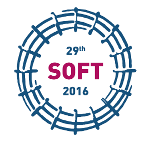Speaker
Julia M. Heuser
(Institute for Applied Materials (IAM))
Description
The investigation of Ceramic Breeders (CB) is of great concern for the development of the solid breeder concept for ITER and DEMO. To ensure an adequate tritium production of the breeder material several requirements like a high lithium density, good tritium release behaviour, and a high resistance against irradiation as well as thermomechanical stresses have to be fulfilled. Lithium orthosilicate (Li4SiO4), applied as pebbles, has been chosen as reference material in the European Helium Cooled Pebble Bed (HCPB) due to its favourable properties.
Studying the behaviour of CB pebbles exposed to relevant neutron irradiation is very important for the development of the EU HCPB and a rare opportunity. Therefore, the HICU experiment (high neutron fluence irradiation of pebble stacks for fusion) was carried out in the High Flux Reactor (HFR) in Petten (Netherlands). Different grades of Li4SiO4 pebbles containing a surplus of 2.5 wt.% SiO2 and different 66Li-contents up to 20 wt.% were included in the irradiation under DEMO relevant conditions (20-25 dpa, 400-900 °C).
Selected results of the Post-Irradiation Examination (PIE) on Li4SiO4 samples will be presented with a focus on the pebble stability and morphology. Changes in the surface morphology, the microstructure and the porosity will be identified by optical microscopy/SEM and Archimedean immersion/He pycnometry, respectively. Investigations of the mechanical strength using crush load tests will reveal possible deteriorations due to neutron irradiation.
The presented results will demonstrate the state of development of CB pebbles and will significantly contribute to the knowledge of CB pebbles' properties in a fusion relevant environment.
Co-authors
Julia M. Heuser
(Institute for Applied Materials (IAM), Karlsruhe Institute of Technology, Karlsruhe, Germany)
Matthias H. H. Kolb
(Institute for Applied Materials (IAM), Karlsruhe Institute of Technology, Karlsruhe, Germany)
Milan Zmitko
(Fusion for Energy, Barcelona, Spain)
Regina Knitter
(Institute for Applied Materials (IAM), Karlsruhe Institute of Technology, Karlsruhe, Germany)
Rolf Rolli
(Institute for Applied Materials (IAM), Karlsruhe Institute of Technology, Karlsruhe, Germany)

